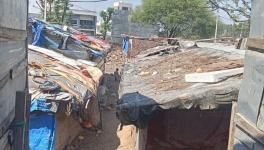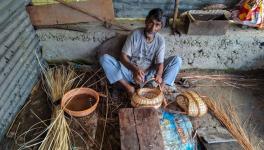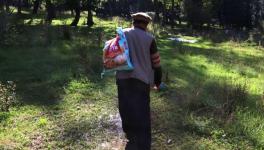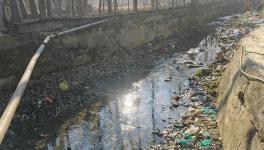Flawed Economic Policies Take a Heavy Toll on Punjab

Flawed economic policies of the Central government, such as demonetisation and the hastily-implemented Goods and Services Tax (GST) regime, have visibly hurt India’s economy. The ripples of the all-round slowdown are now crashing on Punjab’s shores. What the figures and statistics about the decline in auto sales and the farming sector do not show is the effect of the downturn on Punjab, one of India’s most agriculture-dependent states, where modern machinery has made huge inroads into agriculture. Punjab’s farm machinery and garment sectors are in the grip of a severe downturn. A number of these units in different parts of the state have closed down, while many are on the brink of closure.
Sales of tractors are down by 19% and factory closures have left in their wake a stream of unemployed persons. In the cities and other urban centres of the state, more and more workers are reporting their inability to secure more than 15 days of work every month. Even the state’s overall indicators are not encouraging: Punjab’s government fixed a Rs 72,311.85-crore target for revenue collection in the last Budget but a few months ago, it reported collections of only Rs 60,832.28 crore, a significant (15%) shortfall. This fall in revenue is apart from the continuing decline in revenue from GST. Between April and June this year, the state wanted GST collections to increase by 10%. It could only increase this by 7%. In July and August this financial year, this fell to 5%.
Economy-watchers say that ever since the Centre withdrew from circulation currency notes of Rs 500 and Rs 1,000 in November 2016, and thereafter implemented the GST all of a sudden, the economic conditions of all of Punjab’s small industries declined significantly. “Until 2022, the Centre will reimburse states for any shortfall in GST revenues, but if there is no clear improvement in economic conditions by then, Punjab will be in financial dire straits by 2022. We need an environment conducive to investments but creating it is proving tough. Since there are no new investments, consumer wallets have shrunk and their purchasing power has collapsed,” says economist Ranjit Singh Ghuman of the Centre for Research in Rural and Industrial Development (CRRID).
“It has become next to impossible to make ends meet,” an industrialist says. After Chief Minister Amarinder Singh’s Congress government came to power, there were signs of activity in the chimneys at Mandi Gobindgarh Steel City located in Fatehabad district. But delays in executing planned works and the slow pace of installing basic infrastructure have led to a 25% decline in demand for steel. Compared with last year, there is also a 30% decline in the prices of steel, but there is still no uptick in demand. According to the Steel Furnace Association president Mahinder Gupta, in just April this year, demand for steel at Mandi Gobindgarh declined by 25%.
According to senior development economist Sucha Singh Gil, the Central government’s incorrect policies are responsible for the increase in unemployment across the country. “In around the last four months, units supplying goods to the steel and auto industries have closed in large numbers, leaving four lakh people unemployed. But the government has taken no real steps to curb the slowdown that is causing these problems.” On the effects of the slowdown on Punjab, he says that Ludhiana and Mandi Gobindgarh’s cloth and steel industries are the worst affected. “Due to the decline in agriculture, farmers are quitting farming and this is why farmer suicides are going on unabated,” he says.
Punjab Government’s Silence
The government of Punjab is mum on the commitments it made in the budget. Finance Minister Manpreet Singh Badal had admitted in his February 2019 budget speech that Punjab is caught in a vicious debt trap, because its total debt is expected to rise in 2019-20 to Rs 2,29,612 crore. In the Budget session of the Assembly, Badal had promised to waive the loan burden on families of farmers, workers and farm labourers who have committed suicide. A provision of Rs 3,000 crore was also made in the budget for this purpose. Now the state government is silent on this assurance, while banks are pressuring farmers to repay their loans. The government gave the excuse that it bears a heavy annual payout burden of roughly Rs26,979 crore in wages and allowances and another Rs10,875 crore as pensions.
Punjab’s industries linked with agriculture are also grappling with slack demand. Factories that manufacture agricultural equipment and implements—which are mostly in the small and tiny sector—are struggling to survive the ongoing slump. Baldev Singh, who heads the Punjab State Agriculture Implements Manufacturers Association (PSAIMA), which represents small-scale manufacturers, says, “Industries linked with farming have been facing a financial crisis for several years now, but the latest economic decline slump has made our crisis much more serious. It is not just tractors whose sales have declined 19%. Even the fall in sales of combine harvesters and other machinery is at similar levels.”
India’s farm equipment industry does business worth Rs40,000 crore every year. Of this, Rs25,000 crore is the tractor market alone. Sales of other farm machinery and implements are worth Rs15,000 annually. Punjab’s tractor and farm machinery business makes approximately Rs5,000 crore-worth sales every year, which makes it significant in the state’s economy. People in the tractor business say that in August, the fall in tractor sales was even worse. The small machinery-sector players say that the slump is so severe that its impact is being felt by the rural economy as a whole. This is because up to 70% of the workers associated with the small-farm-equipment business belong to Punjab’s rural areas.
The slowdown has crept into industrial city Ludhiana as well. Factory owners say if conditions do not improve, many more units, which are teetering on the brink of shutdown, may close down. Upkar Singh Ahuja, president of the Chamber of Industrial and Commercial Undertakings (CICU) says the country’s slowdown has been felt mostly by the auto sector. The Federation of Punjab Small Industry Associations (FPSIA) president Bideesh Jindal says that the Centre hurt the economy with demonetisation. “The government had set out to make the economy cashless but, in fact, it has made industries cashless,” he says.
The impact of the slowdown is so widespread that the manufacturing index, which was once at 14%, came almost to a halt (0.6%) in September. “Every single industrial sector has slowed down. The auto industry is 40% slower, the cycle manufacturers are 30% down, the hosiery sector has declined by 25-30%. This time we will not see an uptick during the festival season either,” he says.
The government’s decision in August to scrap the special status of Jammu and Kashmir (J&K) also hurt businesses in Punjab. The poultry farmers of Kashmir used to import implements and poultry-feed from Punjab. That business has come to a grinding halt. Trade with Pakistan has also ceased. The border areas are tense and this, too, has hurt Punjab’s investment climate.
Punjab’s textile industry has also slowed down over the last few years but now, after the lock-down was imposed on J&K, things have turned much worse. During the winter months, Kashmiri merchants purchased shawls and woolens from Punjab’s textile hubs in Amritsar in large quantities. In fact, Kashmir is one of the biggest wholesale markets for made-in-Punjab blankets, tweeds and phirans. The garments manufactured in Amritsar were even supplied to Pakistan-Occupied Kashmir (PoK).
The beginning of autumn marks a peak in manufacturing and sales in Punjab’s textile business. The readied garments and textiles would be transported to Kashmir during this season and income from those sales would then pour back into Punjab. Lakhs would be employed in the business over the September-December quarter. Now that the situation in Kashmir has turned dreadful, Punjab’s textile sector is reeling. In Amritsar, the sector has declined by 50% of its sales and purchases compared with the previous year.
Jogender Monga, who runs 25 powerlooms in two units located in Ludhiana, has reduced the work to just one shift. The reason is the lack of demand. “The lockdown in Kashmir has hit manufacturer’s incomes badly,” he says.
A five-hour drive South from Ludhiana, in the bustling industrial-engineering city of Bathinda, around a dozen battery and inverter manufacturers have shut down of late. These businesses have let go of their technical workers, who have now taken to selling goods on push-carts. Bathinda-based Dharmendra Singh, proprietor of SM Batteries, says that small industries need encouragement and relief because they are the biggest source of employment in Punjab and in the country.
American Cotton manufacturers in the Bathinda region are also facing a severe downturn. Twelve years ago, there were 432 American Cotton manufacturers in Ludhiana that employed roughly 45,000 workers. Now there are only 56 such cotton mills left and only 5,000 workers are employed in them. To put it bluntly, 40,000 workers have lost their jobs over the last decade or so. This explains the surge of people waiting every morning at Labour Chowk in the city. At this hub for picking up daily-wage workers, the army of job-seekers is swelling by the day. And things are getting worse. The former president of Punjab Cotton Factories and Ginners Association, Bhagwan Das Bansal, says that the (central) government’s policies have completely rattled textile mill owners and snatched employment from workers. Bansal says that cotton mills market fees in Punjab should be equal to that in Rajasthan.
As per official figures, in the Malwa region of Punjab, a yarn and spinning hub has not proved successful. It is the same story for the cotton mill workers in Bathinda, Barnala, Firozpur, Faridkot and other big cities of Punjab. Labourers return home without being able to find work on most days and the sector has contracted. The worst-affected are rural workers unable to find work.
These days, workers seeking wages arrive at Labour Chowk in Bathinda from rural areas adjoining the district: For example, from Abohar (roughly 80 km away in Fazilka district), Malout (around 50 km away in Muktsar district), and Jaitu (30 km away in district Faridkot), as well. Just this one labour chowk—they exist in every town and city of Punjab—draws around 2,000 seekers every day. A year ago, there were never more than around 1,300 daily-wagers at this crossing on any day. Now, many more gather here and mostly they stand around, hoping to be picked up. Gurdeep Singh, a resident of Bibiwala village says that the economic situation has worsened over the last year. Every month, he remains unemployed for 10 to 12 days, which did not happen before.
Natha Singh, another labourer, says that he only finds work for 15 days every month. Because of the resultant steep fall in his income, he has stopped sending his son to school. This is why experts have been warning the Centre and the state government that the all-around economic crisis has affected each and every aspect of Punjab’s economy —and that the poorer you are, the worse this crisis hits you.
Shiv Inder is an independent journalist in Punjab. Views are personal. A version of this article appeared in Hindi Newsclick on September 26.
Get the latest reports & analysis with people's perspective on Protests, movements & deep analytical videos, discussions of the current affairs in your Telegram app. Subscribe to NewsClick's Telegram channel & get Real-Time updates on stories, as they get published on our website.























